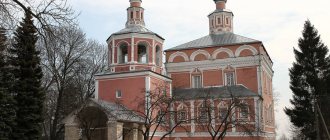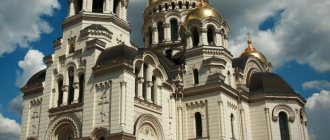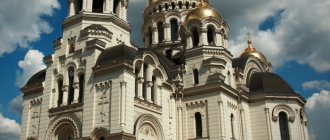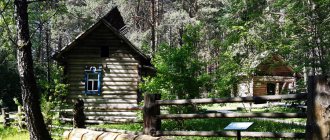Looking at the current quiet Staritsa, whose population does not even reach ten thousand inhabitants, it is difficult to imagine that it once played a vital role in Russian history. And several centuries ago, serious passions raged here. For three centuries since the city's founding in 1297, Staritsa has been at the center of political struggle.
1297 is considered the year of the city’s founding, when the Tver prince Mikhail Yaroslavovich decreed that “the town on the Volza was quickly cut down to Zubtsov on the Staritsa” (Tver Chronicle). Scientists believe that the craft plantation around the Assumption Monastery existed in these places before. There is a legend that once on the site of modern Staritsa there was the city of Lyubim, destroyed and ravaged by the Tatars. The city was never restored, and later, in the 13th century, a fortress was founded here.
Monument to the founder of Staritsa
The most suitable place for the fortress was chosen - a narrow cape towering above the surrounding area. The fortress was located on a high 24-meter hill and was a reliable fortification with earthen ramparts. Those who intended to storm it first had to overcome a ditch filled with water, equipped with iron traps and studded with sharp stakes, then climb the slopes of the hill lined with stone and only then go on an attack. In the center of the fortress in the XIV-XVI centuries there was a Kremlin, surrounded by a four-meter wall made of thick logs with thirteen towers. On its territory there was a cathedral and two churches, a princely palace, the houses of the boyars, the governor's house, a fort, the sovereign's granaries, and the houses of the archers. In the Kremlin, on the Trade Square, there was a lively trade in honey and wax, sterlet and white fish, caftans and felt coats, jugs, sickles and other goods.
What to see in Staritsa in a day: TOP-3 attractions
Once in Staritsa, the first thing you should do is visit its iconic sights - places that are symbols of the city. A visit to them is mandatory and can be done in 1 day.
Holy Dormition Monastery
- Address: st. named after Pushkin, 1A.
The Holy Dormition Monastery became the first link in the history of the founding of Staritsa. It was created in 1110 by Kyiv monks who came to this land with the goal of preaching God's word to the people. Initially, the monastery was a complex of wooden churches and chapels, next to which residential huts were built. This is how a village arose, which later received the status of a city called Staritsa.
In 1312, an internecine war broke out between the Moscow and Tver princes, during which many ancient buildings, including the Holy Dormition Monastery, were destroyed. The monastery was not mentioned in chronicles for about two centuries, from which we can conclude that it was completely destroyed.
The revival of the monastery took place only at the beginning of the 16th century on the initiative of Prince Andrei Staritsky. He moved the monastery to the opposite bank and allocated it a huge territory, which was built up with white stone temples and fortified with a high wall, ramparts and a water ditch.
For centuries, the Holy Dormition Monastery experienced periods of dawn and decline. It burned more than once, was rebuilt, and suffered raids from enemy peoples.
In the first half of the 20th century, the monastery was closed. The wall surrounding it was dismantled for building materials. In 1944, renovations were carried out on the territory of the former monastery to save historical buildings from destruction. Many buildings were mothballed and left in this state until the end of the 1990s. The renovation, which began during the war years, was completely completed by 2013. Then the monastery reopened its gates, and the parishioners saw it in its original form.
Currently, the architectural ensemble includes the following buildings:
- The Cathedral of the Assumption of the Blessed Virgin Mary is a five-domed white-stone church built in 1530 by Prince Andrei Staritsky.
- The gate church in honor of John the Evangelist is a building built in 1694 with arched galleries.
- The Vvedenskaya Church is a two-story building with a hipped roof, built in 1570 by Ivan the Terrible.
- Trinity Church. Erected in 1819 at the expense of Major General Alexei Tutolmin. The lower floor of the building is occupied by the tomb of his family.
The Holy Dormition Monastery is the most famous landmark of Staritsa. Every day there are religious services and excursions in different languages.
Monument to the 700th anniversary of the Staritsa
- Address: Volodarskogo street.
It would be logical to assume that in honor of the 700th anniversary of Staritsa, a monument to its founder, Prince Mikhail Yaroslavovich, was erected in the city, but instead, in 1997, a figure of a woman dressed in a noble dress appeared here. She holds a scroll in one hand and a staff in the other. What does this composition mean?
The history of the creation of the monument is intertwined with an ancient legend, according to which, during one of the Tatar raids, the city was burned to the ground, and the only survivor was a lame old woman who rebuilt the settlement. The legend about her became the brightest moment in the history of Staritsa. There is a legend that the name of the city is associated with that old woman (old woman), but in fact the settlement was named after the river flowing nearby.
Whether the old woman who survived the fire actually lived or not remains unknown. But it was her image that became the city symbol and still adorns its coat of arms. Therefore, the monument in honor of the 700th anniversary of the Staritsa is dedicated to her.
The bronze sculpture is placed on a huge stone, in the center of which there is a memorial plaque indicating that “in the summer of 1297 a town on the Volga was cut down.”
Staritsa quarries
- Coordinates on the map: 56.448745, 34.916837.
The limestone caves, cut in the 12th century, attract a lot of attention from tourists. There are many legends about them, including about the old woman who took refuge here during the Tatar attack and survived. They also tell stories of hidden treasures and missing speleologists.
In the old days, limestone and marble were mined in caves, from which Staritsa temples were built. Today the caves are abandoned and visited only by extreme tourists. It is easy to get lost in the intricate tunnels of the caves, so you should not go here without a guide. Marble pillars and inscriptions hinting at the pioneers serve as landmarks for speleologists. In the future, they want to establish a historical and tourist national park here and classify the quarries as specially protected sites.
The last freemen in Rus'
New Town, as Staritsa was called in those days, led a stormy life: it was built, fortified, burned, repelled enemy attacks, and received distinguished guests. The growing Moscow did not leave him unattended. So, in 1375, Staritsa was captured and plundered by the Moscow prince Dmitry Ivanovich (the future Donskoy). True, I didn’t capture it for long. Soon, the Tver prince Mikhail Alexandrovich, who together with the Lithuanians made a campaign against Moscow, returned the city under his rule. Only in 1485, the Grand Duke of Moscow Ivan III invaded the Tver lands and finally destroyed the independence of the Tver principality. The staritsa became part of the Moscow state.
In 1503, Ivan III, who is called the “great collector of the Russian land,” gave Staritsa as an inheritance to his son Andrei, the younger brother of Prince Vasily - two years later he succeeded his father on the grand-ducal throne. This is what led to the later tragic events associated with the Staritsky princes (Prince Andrei received this title).
Vasily III, who took the grand-ducal throne in Moscow, remained childless for a long time. Only in his second marriage with Elena Glinskaya did he have two sons. After the death of the Grand Duke, Elena declared herself regent for the young heir Ivan Vasilyevich (the future Grozny). Vasily III, having annexed Pskov, Smolensk and Ryazan to Moscow, basically completed the “gathering” of Russian lands. Only the Staritsa principality and Veliky Novgorod remained free and free. This did not suit the regent in any way, and she decided to deal with her, as it seemed to her, dangerous relative. Having heard about this, Andrei Staritsky left the fortress with his army and moved towards Novgorod, expecting to receive support and help there. Glinskaya sent an army led by Voivode Telepnev-Obolensky for the prince. Both squads met, but did not dare to engage in battle. Then the voivode began negotiations and swore that the regent did not want bloodshed, but wanted to meet with Andrei Ivanovich in Moscow to discuss some controversial issues. The prince believed and went to Moscow. There he was immediately captured, shackled and starved to death in prison. The widow of Prince Andrei Euphrosyne (from the Khovansky family) and her son Vladimir were released from imprisonment “in Moscow” only after the death of Elena Glinskaya, in 1539. A year later, the Staritsky family was given back their inheritance. Having matured, Vladimir Staritsky became the closest associate of Ivan the Terrible for many years.
Bell tower and Job Chapel Photo: Natalya Gudkova/commons.wikimedia.org
In 1552, Vladimir Staritsky led Russian troops in the final assault on Kazan, which was especially noted by Ivan the Terrible. In 1562, Prince Vladimir commanded the army that drove the Crimean Khan Devlet-Girey from Russian lands. In 1563, during the Livonian War, he took Polotsk. But not everything was smooth in the relationship between the cousins.
In 1553, during the illness of Ivan IV, many boyars did not want to swear allegiance to his son, Tsarevich Dimitri, but started talking about the Tsar’s cousin Vladimir Staritsky as a possible heir to the throne. Apparently, these alarming events burned into the memory of the young king. And having recovered, he tried to destroy the entire Staritsky family. In 1563, Euphrosyne Staritskaya (Vladimir’s mother) was tonsured as a nun under the name Evdokia and sent to Beloozero, to the Goritsky Monastery.
It all ended in 1569, when Prince Vladimir Staritsky, who led the army sent to defend Astrakhan from the Turks, received a ceremonial reception in Kostroma on his way to his destination. Ivan the Terrible took this as a demonstration of “infidelity” - and his patience ran out. Ivan the Terrible demanded Vladimir with his wife and children to Alexandrovskaya Sloboda, where they were all executed.
This is how the story of the last princely freemen in Rus' ended: the Staritsky inheritance was abolished, and the city was included in the oprichnina.
Which museums in Staritsa are worth visiting?
There are many museums in Staritsa: standard ones, such as local history museums, and original ones, which cannot be found in any other city. The next section will tell you about the most interesting of them.
Architectural, Art and Archaeological Museum
- Address: st. Volodarsky, 38.
The museum was opened in 1919 in a building belonging to the Holy Dormition Monastery. The collection, collected at the beginning of the 20th century, contained valuable exhibits, but was completely lost during the Second World War. The museum began to be restored in 1975.
The updated exhibitions were dedicated to the events of the Troubles of the 17th century, the history of the creation of the Holy Dormition Monastery, and the reforms of Catherine II, who did a lot for the development of the city. The museum also has halls telling about folk crafts: stonemasonry, blacksmithing, pottery and folk applied arts. Individual exhibitions reveal the charm of noble life. The rooms have restored interiors of rich estates. Here you can see authentic furniture of the 18th-19th centuries, costumes, textiles and household utensils.
In 2008, the museum moved to a new building and quickly became a local history center and popular tourist attraction. The museum has a lecture hall and a cinema where educational events for children and youth are held.
Museum of the Russian Stove
- Address: st. named after Gusev, 12.
The most comfortable museum of Staritsa tells about the peasant life of the 18th-19th centuries. The exhibition is housed in a log hut, heated by a large Russian stove. The museum exhibits are homemade objects made of birch bark, wood and clay, which were used by our ancestors. Some of them are genuine, ancient, worn out by the hands of more than one generation of peasants, others are made in our time using old technology.
In the exhibition hall you can see wicker baskets and cradles, clay pots and true antiques: rocker arms, spindles, millstones and samovars. The peculiarity of the museum is that here you can not only look at strange things, but also touch and turn them in your hands, which is very interesting for children.
Porcelain Museum
- Address: st. Karl Marx, 59.
The Porcelain Museum is located in the Mansion on Karl-Marx Hotel. This building truly looks like a luxurious 19th-century manor, and the museum collection is just as aesthetically pleasing. The exhibits are selected with knowledge and taste.
The collection consists of elegant figurines, expensive sets, watches with jewelry trim, exquisite vases, decorative plates with images of historical events, porcelain frames containing paintings and photographs. The museum opened recently, and its collection is constantly updated with new original products.
Museum A.S. Pushkin
- Address: Bernovo village, Mira Square, 9.
The Pushkin Museum is located in the village of Bernovo. The exhibition halls are occupied by a stone mansion of the 18th century, in which the Wulfs, friends of the poet, lived. The museum opened in 1971. The exhibition is dedicated to the life and work of Alexander Sergeevich.
The rooms recreate the atmosphere in which the poet lived and worked. Excursionists are presented with authentic furniture, goose feathers and inkwells, manuscripts, books in expensive bindings and the poet’s personal belongings.
In the park along the pond there are several monuments to Pushkin, and his favorite place is marked, where the pine trees he planted grew. Every first Sunday in July, the museum celebrates Poetry Day, to which residents of nearby villages and towns are invited.
Museum of Admiral Kornilov
- Address: Staritsky district, Ryasnya village.
Vladimir Alekseevich Kornilov is a vice admiral of the Russian Imperial Fleet, the founder of positional methods of warfare and a hero of the Crimean War. In 2009, in the admiral’s native village, Ryasna, a museum dedicated to his life and exploits appeared. The exhibition is located in a small one-story house, in front of which there is a stone bust of Kornilov.
How to get there
By bus from Tver (flights to Staritsa, Rzhev, Toropets, Western Dvina, about 15 flights per day, the journey takes 1.5 hours), Rzhev or Moscow (2 flights, the journey takes 4 hours).
If you are coming from Moscow, the most convenient way is to get to Staritsa via Tver, and leave for Moscow by direct bus.
It is worth keeping in mind that the bus is assigned to Volokolamsk, and if there are few passengers traveling from Staritsa, in Volokolamsk they are transferred to another bus.
By car, it is better to drive from Moscow along the M9 highway through Volokolamsk and Rzhev, then turn along A112, at 289 km. From the northern capital, follow the M10 highway to Tver, then turn onto the A112 for 600 km.
Find cheap flights to Staritsa
What architecture to visit in Staritsa
Modern Staritsa carefully preserves the monuments of its past - ancient buildings that for centuries have formed its unique appearance.
Shabunin's house
- Address: st. Karl Marx, 30.
The wooden estate was built in 1918 by cabinetmaker Shabunin. This house would have been an unremarkable peasant building if not for the imagination and talent of its owner.
Shabunin turned his hut into a work of art, decorating it with profuse and intricate carvings. You can look at the façade of the building endlessly. The number of small details and patterns literally dazzles the eyes. There are palm branches, human masks, wolf faces, brackets, platbands and delicately crafted openwork pilasters.
Currently, the house is the private property of Shabunin’s descendants, but the owners do not prohibit tourists from photographing the building and getting closer to it in order to properly examine the carved decorations.
House of merchant Filippov
- Address: Lenin street, 18.
The merchant's house is the pearl of Staritsa. This is a beautiful 19th century white stone building in the classicist style. The facade and mezzanine are decorated with slender half-columns, panels and friezes. The mezzanine is equipped with a veranda with wrought iron railings.
The Filippov family lived here until 1918, and then migrated to Europe. The building was classified as an architectural monument and a cultural and leisure center was opened in it. The interior rooms are decorated in the style of the state halls of the nineteenth century. This design move gave the building even more charm.
Malinniki Estate
- GPS coordinates: 56.663158, 34.595114.
In the vicinity of Staritsa there is an old estate that belonged to P.A. Osipova-Wulf, who was visited by Alexander Pushkin several times. Here, in the silence of nature, the poet worked on creating a novel in verse, “Eugene Onegin.”
In 1923, the stone mansion was destroyed, and all that remained of the estate complex was a log chapel and a park in which a monument to A.S. was erected. Pushkin. Today, the Malinniki estate is part of the “Pushkin Ring of the Upper Volga Region” and is regularly visited by tourist groups.
Konoplino Estate
- Coordinates: 56.565415, 34.983198.
The main attraction of the estate complex is a stone mansion in the classicist style. The huge building with wings is decorated with a portico with a number of massive columns, strict sandstones and arches. Near the mansion there are wooden outbuildings.
The estate was built by the writer I.I. Lazhechnikov, later it passed to the Loshakov family, and then to Major General F.V. Shimarev. The latter was fond of breeding thoroughbred horses and built several stables on the estate.
After Shimarev's death, the estate passed into the possession of his widow. She founded a convent here, which existed before the revolution. During the Soviet period, the estate was used as a nursing home.
Today Konoplino is again private property. All buildings have been restored, and ancient structures have been preserved in the corners of the vast park: wells and monumental compositions. Entry into the mansion is prohibited, but the park is open to the public.
White stone forges
- Address: Lenin street.
Two hundred years ago, Staritsa’s main craft was blacksmithing. On the hills of the left bank of the Volga there was a complex of white-stone forges, where work was in full swing from early morning until late evening. Today, out of 32 buildings, only 7 have survived.
Half of the buildings were destroyed by people, half went underground due to landslides on the steep bank. The remaining buildings are recognized as historical and architectural monuments. This place, although abandoned, looks very unique, so it is very interesting to visit.
Staritsky Bridge over the Volga
- Coordinates: 56.510841, 34.932079.
Since time immemorial, the left-bank and right-bank parts of the city were connected by a dilapidated wooden bridge, but in 1963, a new arched structure arose in its place, which became the compositional center of the city. The Staritsky Bridge was repaired in the late 1990s and today is an important link in the Tver-Rzhev highway.
Konoplino Estate
The construction of the Konoplino estate was carried out in 1747. Since 1835, the famous Russian writer I.I. became the owner of the estate. Lazhechnikov.
Within the walls of the house were written the world-famous works “Basurman”, “Oprichnik”, “Camping Notes of a Russian Officer”. A.F. Shishmarev raised and trained thoroughbred horses on the territory of the estate, which received many prizes in prestigious competitions. In 2000, the estate was restored to its original form and given over to private ownership.
Staritsa temples, cathedrals and churches
The temples and cathedrals of Staritsa are its oldest buildings. Some of them are destroyed and lie in ruins, others participate in the modern life of the townspeople.
Church of Elijah the Prophet
- Address: st. Volodarsky, 46.
The Staritsa Ilyinskaya Church was first mentioned in the scribe books of 1624. It was a log building, which soon fell into disrepair, and the parishioners requested a new stone church. But it was impossible to build the church in its original location, so it was moved to the square at the entrance to Tverskaya Street, where it stands to this day. The church in honor of Elijah the Prophet is made in the classicism style.
The drum of the main building is surrounded by towers topped with silvery domes. The refectory room connects the church with the high bell tower. The design of the building is designed in a strict, elegant manner. Its brightness is given by the yellow coloring with whitewashed decorative elements.
In the 1930s, the church was closed and its halls were converted into warehouses. Despite the fact that the building did not receive care for a long time and was used for other purposes, it retained its decent appearance and returned to the parishioners in good condition in the late 1990s. Today, the Ilyinskaya Church is operational; daily services are held there and Orthodox holidays are celebrated.
Boris and Gleb Cathedral
- Coordinates: 56.509301, 34.927507.
Boris and Gleb Cathedral is a monumental white stone church in the classicist style. It attracts attention with majestic domes, an elegant attic and a pediment of a 4-columned portico. No less impressive is the nearby three-tier bell tower topped with a sharp spire. The cathedral was built in 1827 and served the townspeople until the 1920s, when it was closed and abandoned.
The building had been empty for a long time and, due to lack of proper maintenance, began to collapse. In 1979, it was preserved, and the surviving interior details (including the ceramic panels “Crucifixion” and “Savior”) were moved to Moscow museums. Today the cathedral is closed and awaiting restoration.
Ascension Monastery
- Address: City Garden.
The convent building was built in 1570. According to legend, its founder was Ivan the Terrible himself. Initially, the church was wooden, but in 1637 it burned down, and a new building made of white hewn stone was built in its place. The church had two floors and a three-tier bell tower with a spire.
In the second half of the 18th century, by decree of Empress Catherine II, the monastery was abolished, and the Ascension Church received the status of a parish church, which existed until 1935. During the Soviet years, the Ascension Church stood in an abandoned state and was badly damaged during the Nazi occupation. After the war, they tried to equip the building as a club, but the damage was too serious and repair work stopped.
Today the church is in ruins and on the verge of extinction. The upper floors and roof have collapsed, windows and doorways gape empty. Ancient inscriptions in Old Russian are still visible on the walls. In the vicinity of the monastery, a necropolis of the 16th century with the remains of white stone tombstones has also been preserved.
The Ascension Church is famous for the fact that in 1982 the film “Scarecrow” was filmed there, in particular the key scene of the burning of a rag doll.
Resurrection Church
- Address: Privolzhskaya st., 5.
The Resurrection Church was built at the end of the 18th century by Staritsky architects. It was a beautiful white stone building with a drum covered with a spherical dome. The temple housed valuable books and ancient icons that were looted and destroyed during Soviet times.
The temple was abandoned for a long time, until it was bought into ownership in the early 2000s. Unfortunately, the new owners of the landmark did not take care of its preservation - it is slowly falling into disrepair, attracting the attention of lovers of “abandoned places”.
Paraskeva Pyatnitsa Church
- Coordinates: 56.509319, 34.929851.
Built in the 17th century, the white stone church is a unique example of Old Russian architecture. The unique composition includes arrays of different shapes and levels. The cascading roofs are crowned with rounded domes, and the tiered bell tower is covered with a polygonal dome with a high spire. The main entrance is marked by a pediment with a pair of marble columns.
Until the beginning of the 20th century, the Church of Paraskeva Pyatnitsa was a significant religious center of Staritsa, but today this building is abandoned. Despite its dilapidation, it has retained the outlines of its former beauty, which attracts tourists. Inside the church, ancient frescoes have been preserved, decorating the walls and majestic vaults. Across the road from the temple is a small chapel of Alexander Nevsky built in 1866.
Assumption Church
The church is located in the village of Ivanishi. The construction of the monastery, to which the church belongs, was carried out in 1534-1542 thanks to funding from the boyar Podzhogin. There is a legend that says that the monastery was built after a traveler was cured of unbearable stomach pain at the site of the temple.
The temple was located on a hill. The monastery has a rectangular shape with onion-shaped domes; the façade is divided into three main parts. Nowadays, the temple is not operational and is under restoration.
Historical memorials of the city of Staritsa
On the territory and in the vicinity of Staritsa there are many memorial signs erected in honor of historical events and legendary personalities.
Monument to fallen soldiers
- Address: Volodarskogo street.
The monument is dedicated to the memory of Russian soldiers who died during the liberation of Staritsa. It consists of two 7-meter steles, which are united by a marble slab with the profile of an ordinary soldier. The monument was erected in 1970. You can find it in a quiet park not far from the Assumption Monastery.
Monument to M.V. Zakharov
- Address: Volodarskogo street.
Matvey Vasilyevich Zakharov is a Soviet military leader who was twice awarded the title of Hero of the Soviet Union for his exploits in the Great Patriotic War. Staritsky district was his small homeland, so in 1981 a monument was erected here in his honor.
The bronze bust of the hero, placed on a high granite pedestal, was made by the talented sculptor G.N. Postnikova. The monument is located on the platform, to which a wide staircase leads. It is surrounded by a picturesque park with aspen alleys.
Bortenevskoe field
- Coordinates: 56.407673, 35.425090.
In the vicinity of Staritsa there is a field where in 1317 the founder of the city, Prince Mikhail Tverskoy, defeated the united army of Moscow Prince Yuri Danilovich and the Temnik of the Golden Horde of Kavgady, which came to the Tver Principality. However, for this victory in 1318, Prince Mikhail was executed.
Today, on the site of the Bortenevskaya battle, a memorial complex has been opened, which includes a stone embankment with a monolithic cross and the chapel of Mikhail Tverskoy. Next to the chapel there is a memorial plaque with a brief history of the fatal battle.
Natural places of Staritsa and its surroundings
In the vicinity of Staritsa there are several corners that allow you to escape from the bustle of the city and enjoy the tranquility of natural landscapes.
Shchapovsky ravine
- Coordinates on the map: 56.464038, 34.940242.
The karst ravine stretches for 2.5 kilometers. Between the steep slopes covered with rich vegetation, a turbulent stream flows, which either winds like a ribbon or runs down the stone steps, forming small waterfalls.
On the banks of the stream you can see rare species of fern and lady's slipper, listed in the Red Book. Also found here are valuable limestone rocks, mollusk shells and even fossils of prehistoric ammonites and coral polyps.
The Shchapovsky ravine is famous for its cave systems inhabited by bats. It is dangerous to go inside the caves due to frequent screes, but no one forbids taking a walk near this attraction.
City Garden
- Coordinates: 56.506752, 34.937194.
The city garden is a very unusual place. It is a deciduous grove with narrow sandy paths running through it. The area is not landscaped. There are no flower clubs, smooth alleys or fountains here, only lush grasses, forest thickets and open glades. Walking along the paths, you can see old stone sculptures and monuments hidden in the thickets.
Between the trunks of two aspen trees lies a boulder on which a rusty anchor is placed, and in the open space there is a white stele indicating a Bolshevik burial. But the main attraction of the garden is the ruins of the Church of the Ascension, rising from the tall grass like a ghost of the distant past.
Staritsa Gate
- Coordinates: 56.510193, 34.940301.
Staritsky Gate is one of the most beautiful places in the city. Here the green banks of the Volga rise and narrow, and its flow accelerates, cutting through the thickness of the limestone rock. The best way to admire the beauty of the Staritsa Gate is to kayak downstream. Sailing past the high banks, tourists will have a beautiful view of the city, limestone gorges and ancient buildings built at the water's edge.
Forest "Seltsovskie Zalomki"
- Coordinates: 56.536382, 34.911936.
“Seltsovskie Zalomki” is a natural monument and a state-protected area. Activities for the conservation and research of the flora and fauna of the Tver region are carried out here. The luxurious coniferous forests are home to plants listed in the Red Book and are home to rare species of animals and birds.
The forest is a popular eco-tourism destination. Small tourist groups go hiking and rafting on local lakes and rivers. Travelers are prohibited from hunting, cutting down bushes, fishing, picking berries, mushrooms and medicinal herbs. In other words, “Seltsovskie Zalomki” is a natural museum where you can look, but you cannot touch.
Sled sports center "Eco-Land"
- Address: Chukavino village, Staritsky district.
In the village of Chukavina there is a unique sledding sports complex. His repertoire includes sleigh rides drawn by horses, deer, dogs, and camel rides. Guests are invited to take a short trip through the snowy expanses, and then take pictures with the animals and have a delicious lunch in a local cafe.
Tours are available by appointment only. It is also possible to order the organization of family and public celebrations at the center.
Don't miss reviews of attractions in other cities of the Tver region:
- Ostashkov, Bezhetsk, Vyshny Volochok,
- Konakovo, Likhoslavl, Kashin, Bologogo, Torzhok,
- Toropets, Kalyazin, Rzhev, Kimry and Tver
Each Russian province is unique in its own way, Staritsa is no exception. Its ancient history is impressive, its natural beauty delights, and excursions cause genuine delight. Not a single traveler whose road turned towards the Tver region will regret the time spent in this town.











